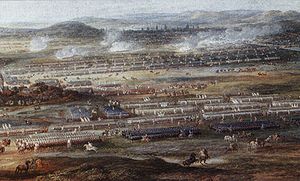Today in History - October 11th
October 11, 1746 The Battle of Rocaux
The Battle of Rocoux (11 October 1746) was a French victory over an allied Austrian, British, Hanoveran and Dutch army outside Liege during War of the Austrian Succession.
The French main attack went against the Dutch portion on the left of the allied line between Liege and Rocoux, heavily defeating it on the third assault.[7] In the face of a general French advance the allied line began to give way. The Austrians on the allied right were not engaged and made no attempt to take the iniative and advance against the exposed French left flank. Lingonier's cavalry and some British infantry formed a rear guard that held off the French as the army withdrew. The French were victorious, immediately capturing Liege and breaking Austrian control over the Netherlands.

The Battle of Roucoux, 1746
October 11, 1776 Battle of Valcour Island
The naval Battle of Valcour Island, also known as the Battle of Valcour Bay, took place on 11 October 1776, on Lake Champlain in a narrow strait between the New York mainland and Valcour Island during the American Revolutionary War. It is generally regarded as the first naval battle fought by the United States Navy. Although the American ships under the command of Benedict Arnold were mostly destroyed, the campaign delayed by one year the British attempt to cut the colonies in half and eventually led to the British military disaster at Saratoga in 1777.
Arnold came from a seafaring Connecticut family. He shrewdly chose to force the British to attack his inferior forces in a narrow, rocky body of water between the coast and Valcour Island, where the British fleet would have difficulty bringing its superior firepower to bear, and where the inferior seamanship of his unskilled sailors would have a minimal effect.
The British fleet took up positions at noon around 300 yards (c.300 m) in front of the American battle line with the small gunboats forward, and the five main ships around 50-100 yards behind the gunboats. The British then opened fire with a heavy broadside against the American ships, which continued for the next five hours. During the exchange of cannon fire, Revenge was heavily hit; Philadelphia was also heavily hit and sank later at around 6:30 p.m. Royal Savage commanded by Captain David Hawley ran aground and was set on fire by the crew to prevent the ship from falling in British hands. Congress and Washington were heavily damaged; Jersey and New York were also badly hit. On the British side, casualties began mounting, as well. HMS Carleton was heavily hit as it tried to land a boarding party on the grounded Royal Savage and was forced to withdraw under heavy fire. One small gunboat, commanded by Lieutenant Dufais, blew up and sank from a direct hit. Most of the other small gunboats were also hit, forcing them to withdraw and reform their battle line 700 yards from the American line. Two of the gunboats were so heavily damaged that their crews were forced to scuttle them after the action.
Nonetheless, the battle had gone against the Americans when the sun set on 11 October. Most of the American ships were damaged or sinking, and the crews reported around 60 casualties. The British reported around 40 casualties on their ships. Aware that he could not defeat the British fleet, Arnold decided to withdraw. Arnold managed to sneak his fleet past (and through) the British fleet during the night and attempted to run for the cover of the shore batteries situated at the American-held fort at Crown Point at the south end of the lake. Unfortunately, the weather did not cooperate, and the Americans were caught short of their goal. As the British pursued, Colonel Guy Carleton mistakenly fired upon a small rocky island, thinking it was an American ship. The small island was later named Carleton's prize.

Position of American ships on Lake Champlain

0 Comments:
Post a Comment
<< Home